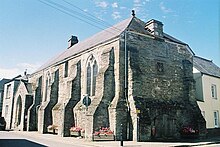Cornish Stannary Parliament
The Cornish Stannary Parliament (officially The Convocation of the Tinners of Cornwall)[1] was the representative body of the Cornish stannaries, which were chartered in 1201 by King John.[2] In spite of the name, the Parliament was not a Cornish national assembly, instead representing the interests of the tin industry; however, due to the significant proportion of Cornwall's population involved in the tin trade, it wielded considerable power.[1][3]
History[edit]
Background[edit]
The stannaries are said to have first been acknowledged by the Crown in 1198,[4] but formal recognition came with a 1201 charter from King John which affirmed the ancient rights tinners (those involved in mining tin) enjoyed.[1] The charter exempted tinners from common taxes (though the stannaries had their own tax system) and made the Lord Warden of the Stannaries the sole magistrate with jurisdiction over them.[1] Tinners were also protected from being called up to provide labour to local lords of the manor while they were working in the tin industry.
Parliament[edit]

A Cornish Stannary Parliament building was built at Lostwithiel in 1305.[6] The suspension of the Stannary Parliament and curtailing of tinners' tax exemption rights in 1496 is seen to be one of the factors in the 1497 Cornish rebellion.[7]
The Stannary Parliament met at Lostwithiel[8] and Truro throughout its existence.[9] Being the seat of the Parliament is credited as one of the factors that caused Truro to become a "significant administrative centre".[10]
According to Thomas Pitt, no Stannary Parliament sat between 1710 and 1750, though efforts had been made from 1744 to try to get the Parliament recalled.[11] The last session of the Stannary Parliament convened in Truro in 1752, being adjourned in September 1753.[12]
Because the Stannary charters have never been revoked, some argue that the powers and rights of the Stannary Parliaments are still extant.[13]
Procedure and powers[edit]
Members of the Stannary Parliament were called stannators.[9] The 24 stannators, six from each of the four Cornish stannaries (Tywarnhaile, Blackmoor, Foweymoore and Penwith),[14] had the power to pass laws which had effect over the whole of Cornwall in the same way as an Act of Parliament.[6][15]
The Parliament was summoned by the Duke of Cornwall and the Lord Warden of the Stannaries issued notices to each of the stannary towns (Truro, Lostwithiel, Helston and Launceston) ordering elections for six stannators from each. At the opening of the Parliament the Lord Warden would make a speech, oversee the election of a speaker, and then be excluded. 24 assistants were appointed to help with the drafting of legislation, forming an informal lower house.[1]
The Stannary Parliament also held the power of veto over Westminster laws that affected the stannaries;[4][6] to become law, a bill which affected mining needed the approval of every stannator, the Lord Warden, and the Duke of Cornwall.[9] From 1752, bills from the Stannary Parliament needed the assent of sixteen members of the Westminster Parliament but as Cornwall was hugely overrepresented in Parliament,[note 1] this was less of a burden than it would be today.
See also[edit]
Notes[edit]
References[edit]
- ^ a b c d e John Kirkhope (Autumn 2017). "THE SEIGNIORY OF SARK AND THE DUCHY OF CORNWALL: SIMILARITIES AND DIFFERENCES INCLUDING OBSERVATIONS ON THE ISLES OF SCILLY" (PDF). Plymouth Law and Criminal Justice Review. 9: 1–14. Retrieved 21 June 2021.
- ^ Rod Lyon (2012). "Cornwall's Historical Wars: A Brief Introduction". The Cornovia Press. pp. 15–19. ISBN 9781908878052. Retrieved 21 April 2019.
- ^ Paul March-Russell (2017). "The abcanny politics of landscape in Lucy Wood's Diving Belles" (PDF). Short Fiction in Theory & Practice. 7 (1): 56. doi:10.1386/fict.7.1.53_1. ISSN 2043-0701. Retrieved 21 June 2021.
- ^ a b Reitemeier, Frauke, ed. (2015). "The Construction of Cornish Identity". Transfers and Transmutations (PDF). Göttingen: Universitätsverlag Göttingen. p. 233. ISBN 978-3-86395-244-0. Retrieved 21 June 2021.
- ^ "FREEMASONS' HALL". Historic England. Retrieved 21 June 2021.
- ^ a b c "The Cornish Stannaries". Cornwall For Ever!. Retrieved 21 June 2021.
- ^ "Timeline of Cornish History 1066-1700 AD". Cornwall County Council. Archived from the original on 19 June 2006. Retrieved 21 June 2021.
- ^ "The Stannary Parliament convenes at Lostwithiel with Sir Walter Raleigh likely presiding". Encyclopedia Virginia. Retrieved 21 June 2021.
- ^ a b c James Quick (January 1879). "The Old Stannaries of the West of England". Journal of Science. 16: 282–286. Retrieved 21 June 2021.
- ^ "Truro". History of Parliament Online. Retrieved 21 June 2021.
- ^ Thomas Pitt (1751). A state of the proceedings of the convocation, or, parliament for the Stannaries of the County of Cornwall, held at Lestwithiel, on Tuesday the 28th day of August 1750, and at Helstone by Prorogation on Saturday the 20th of October following: and also the point in dispute between the Lord Warden, and the House of Stanators, impartially stated, and fairly discussed. London: R. Baldwin, at the Rose, in Pater-Noster-Row. p. 2. Retrieved 3 February 2022 – via Bodleian Libraries.
- ^ Henry Thomas De la Beche (1839). Report on the Geology of Cornwall, Devon and West Somerset. Longman. pp. 618–619.
- ^ Cheryl Hayden (2008). Payton, Philip (ed.). "1549 –The Rebels Shout Back". Cornish Studies. 16. University of Exeter Press: 206–228. doi:10.1386/corn.16.1.206_1.
- ^ Graham Haslam (1980). An Administrative Study of the Duchy of Cornwall, 1500-1650. Louisiana State University. pp. xiii–xiv.
- ^ Alan Wharam (November 1973). "Judicial Control of Delegated Legislation: The Test of Reasonableness". Modern Law Review. 36 (6): 611–612. doi:10.1111/j.1468-2230.1973.tb01390.x.
- ^ "History of West Looe Town Trust". West Looe Town Trust. Retrieved 22 June 2021.
- ^ C. W. Boase (April 1890). "Review: The Parliamentary Representation of Cornwall to 1832". The English Historical Review. 5 (18). Oxford University Press: 368–371. JSTOR 546436. Retrieved 22 June 2021.
- ^ Eveline Cruickshanks (June 1986). "The convocation of the Stannaries of Cornwall: The parliament of Tinners 1703–1752". Parliaments, Estates and Representation. 6 (1): 59–67. doi:10.1080/02606755.1986.9525680. Retrieved 21 June 2021.
